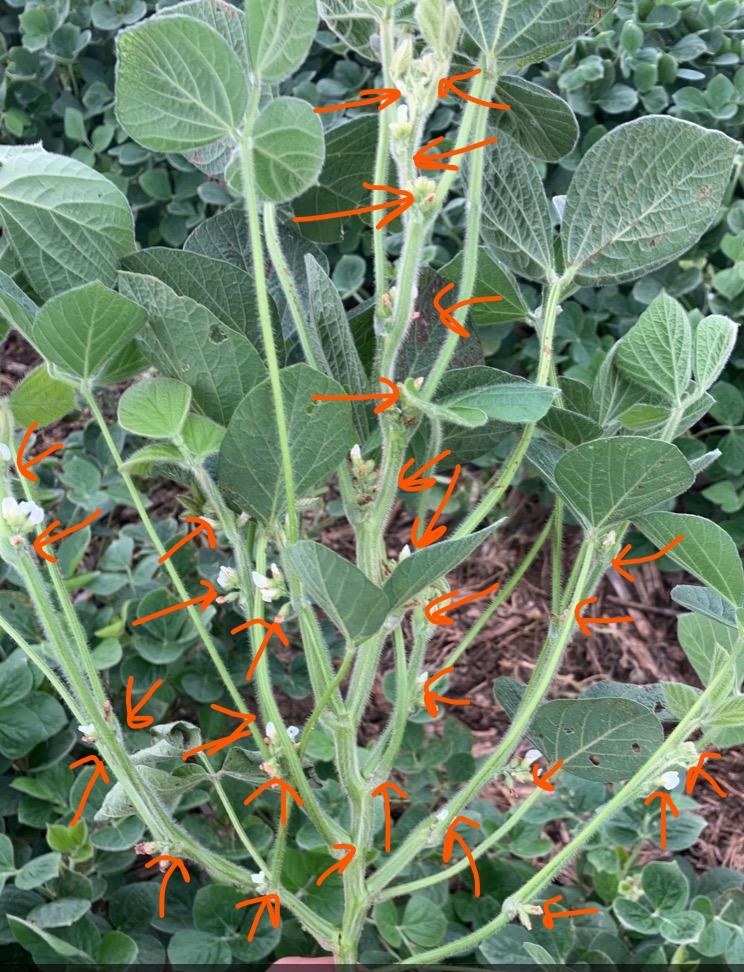July 22nd, 2022
posted
by Andrew Blomme on 7/22/2022
in
Weekly Newsletter

July 22nd, 2022
VT, or the tassel stage in corn, marks the transition from vegetative growth to reproductive development and is halfway point in this corn crop. As we approach this mid-point I made "Mid-Term Report Cards" for the corn and soybean crop in the area.
Corn Mid-Term Report Card
Strengths: High temperatures and average rainfall over the first half of the growing season have helped late planted corn develop very quickly. Those late planted hybrids are almost caught up to as if they were planted in early May on an average year.
Above ground growth has been awesome. We have big, tall, robust plants with a lot of leaf area to convert sunlight to starch as we progress into grain fill.
Pre-pollination kernel counts are at average to above average levels. There are a lot of potential kernels out there to be fertilized and develop into grain.
Weaknesses: Compaction! Below ground there are a lot of issues impacting root development. Sidewall compaction and tillage compaction layers are the most common. These issues effect water and nutrient uptake of the crop and will effect late season standability as well.
Diseases are developing earlier this year than in 2020 and 2021. Over the past 7 days Gray Leaf Spot has begun to develop across the county. There is a lot of tattered leaf material from June wind storms that I believe is helping speed up the onset of certain fungal diseases in the area. Unlike root issues, this is a factor that we still have the opportunity to control with a fungicide application.
Overall Grade: B, Certainly Will Change Before Fall
In spite of some of the weaknesses of this crop I think we can still have an above average corn crop. That being said I think our corn yield potential already has a ceiling on it, especially with some of the wide spread root issues in the area. Mother Nature will have the final call on what this crop will be based on the amount of rainfall we get through grain fill. We are a ways from a disaster but realistically set your expectations below 2021 levels.
Soybean Mid-Term Report Card*
*I scout across every soybean trait that is commercially available, including non-GMO beans. That being said, the vast majority of acres I cover are Enlist beans and so this will be heavily skewed towards what I've seen in those fields.
Strengths: The unbelievable number of nodes on these soybeans! Tough planting conditions, high volumes of residue from last year, and off target herbicide movement have are contributed to the slow growth of soybeans in the area. While GROWTH has been slow, DEVELOPMENT has been very rapid and these short, stubby beans have developed a tremendous number of nodes. The picture below shows an Enlist soybean plant that faced all of the issues noted above and has 31 nodes, denoted with the orange arrows. Each node is likely to produce 10 flowers so this plant already has 310 chances to set a pod. That number will grow.

Soybean growth is picking up steam. These beans are starting to really take off. Canopies are extending across the row and the beans are getting some height to them. They will only grow faster.
Weaknesses: The slow start. Soybeans across all trait platforms appeared to be slow out of the gates again this year. Cold soils, tough planting conditions, and high residue levels from last year have influenced this slow start.
Japanese beetles are starting to fly into the area. At the moment they have been mostly contained to the southern part of our territory but they could easily work their way northward.
Overall Grade: A- and Rising
I am more bullish on the beans compared to the corn at the moment. These plants have a huge number of nodes to set a tremendous number of potential pods and they will continue to grow very rapidly into big, robust plants. If we can limit the stress these plants experience over the next 2-3 weeks and increase the proportion of flowers that become pods then we could have a heck of a soybean crop this fall. Time will tell but I am optimistic.